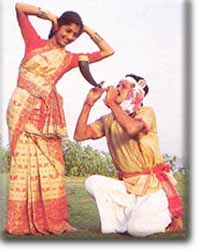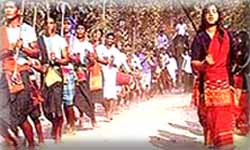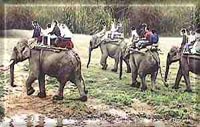 |
||
Bihu : The Bihus are the national festivals of Assam. There are three such festivals in Assam: in the months of Bohaag (Baisakh, the middle of Appril), Maagh (the middle of January), and Kaati (Kartik, the middle of October). The Bihus have been celebrated in Assam from ancient times. Each Bihu coincides with a distinctive phase in the farming calendar. The Bohaag Bihu marks the New Year at the advent of seeding time, the Kaati Bihu marks the completion of sowing and transplanting of paddies, and the Maagh Bihu marks the end of the harvesting period. Bohaag Bihu is also called the Rongaali Bihu or the Festival of Merriment, Maagh Bihu is also called Bhogaali Bihu or the Festival of Food, Kaati Bihu is also called Kongaali Bihu or the Festival of the Poor. The merriments include dances accompanied on the wild and lusty beats of Dhol and Pepa (buffalo hornpipe). Songs sung in this Bihu are woven around themes of love and often carry erotic overtones. People adorn traditional attires like Dhoti, Gamocha and Chadar, Mekhala. |
||
Of the three Bihu festivals which are secular and non-religious, the Bohaag Bihu ushers in the period of greatest enjoyment and marks the arrival of Spring. The folk songs associated with the Bohaag Bihu are called Bihugeets or Bihu songs. The Bohaag Bihu lasts for several days during which "the young people in the village may be seen moving about in groups gaily dressed or forming circles in the midst of which the prettiest girls dance" singing songs of love and romance. Such gatherings are called Mukoli Bihus (Open Bihus). The songs are very popular among all sections of the people. The Magh Bihu or Bhogali Bihu is celebrated in January. Feasting animal and bird fights accompanied by dance and music form entertainment part of this Bihu. Kati Bihu or Kangali Bihuis celebrated in Kartika or October-November. The main attraction of Bihu has been the distinct dance that is mainly done by young boys and girls. Brisk stepping, flinging. Almost all ethnic groups of Assam have their own distinct style of Bihu dance. |
 Bihu Dance |
|
|
Ali-Ai-Ligang
: |
||
 Rava Dance |
Bohaggiyo
Bishu : Unrestricted joy, merriment and fun accompany the Bohaggiyo festival that is celebrated during mid-April at a stretch for seven days. The term Bishu can be understood as 'Bi' means extreme and 'Su' means rejoicing. This festival is mainly celebrated by the Deoris. It is commonly believed that this festival comes on Sankranti day but observations prove this is not a fixed rule. But the festivals begin on Wednesday and it is initiated by Than Puja. Every fourth year a buffalo is sacrificed. This sacrifice is in place of the traditional human sacrifice. Deodhani dance and Husori or carol songs are the main attractions of the festival. |
|
| Rajini
Gabra & Harni Gabra : This essentially a religious practice before starting the new cultivation. The Dimasa tribe celebrates the festival. Rajini Gabra starts with Kunang or the village headman propitiating the family deity by closing the village gate on the Puja day. In the night, presiding deity is worshipped for protection and prosperity of the people. This function is called Harni Gabra. An interesting feature of this festival is that if any outsider enters the functions after the gates are closed, then the celebrations are considered spoiled and the intruder has to bear the cost of starting the functions afresh. |
 Dimasa Dance |
|
 Karbi Dance |
Rongker
and Chomangkan : |
|
| Baikho
: Baikho is essentially a spring festival, which is celebrated to propitiate the goddess of wealth 'Baikho'. The various groups of Rabha community celebrate this festival. Dosa Thoi! Long Nai : A very important religious dance festival performed the Bathou Puja dedicated to worship of Lord Shiva. In this the priest dances Deodhani dance with a bowl on his head. |
||
|
|
||
|
|
||